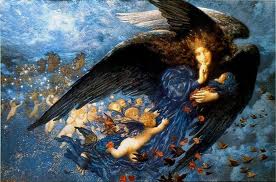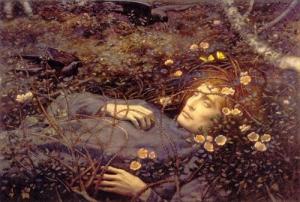 Edward Robert Hughes (1851 – 1914) is one of the painters whose works are more familiar than his name. Paintings such as Midsummer’s Eve, a chocolate box painting which no doubt adorns many souvenirs, and the beautiful Night with her Train of Stars, are familiar when Hughes’s name isn’t. He was, in fact, the nephew of Pre-Raphaelite painter Arthur Hughes, and devoted his life to the art of the PRB. This and much more I learned from a fascinating lecture on E.R. Hughes by Victoria Osborne for the Pre-Raphaelite Society, based on the research she is doing for Birmingham Museums and Art Gallery’s exhibition on Hughes which is scheduled for Autumn 2014, the year of Hughes’s centenary. The lecture was entitled ‘One of the very last votaries of the Pre‑Raphaelite Brotherhood: E.R. Hughes and the Death of Pre‑Raphaelitism’, and examined how the influence of the PRB shaped the life and artistic vision of Hughes. On his death, critics seemed prepared to declare the Pre-Raphaelitism died with him, with a sub-text of ‘about time, too’, as though the Brotherhood’s ideals had outlasted their usefulness. Victoria suggested that Hughes might be seen as an early European Symbolist as well as a belated Pre-Raphaelite, though, which raises some interesting questions. The overall view, however, seems to be that Hughes might have been a better painter without his devotion to the PRB, which
Edward Robert Hughes (1851 – 1914) is one of the painters whose works are more familiar than his name. Paintings such as Midsummer’s Eve, a chocolate box painting which no doubt adorns many souvenirs, and the beautiful Night with her Train of Stars, are familiar when Hughes’s name isn’t. He was, in fact, the nephew of Pre-Raphaelite painter Arthur Hughes, and devoted his life to the art of the PRB. This and much more I learned from a fascinating lecture on E.R. Hughes by Victoria Osborne for the Pre-Raphaelite Society, based on the research she is doing for Birmingham Museums and Art Gallery’s exhibition on Hughes which is scheduled for Autumn 2014, the year of Hughes’s centenary. The lecture was entitled ‘One of the very last votaries of the Pre‑Raphaelite Brotherhood: E.R. Hughes and the Death of Pre‑Raphaelitism’, and examined how the influence of the PRB shaped the life and artistic vision of Hughes. On his death, critics seemed prepared to declare the Pre-Raphaelitism died with him, with a sub-text of ‘about time, too’, as though the Brotherhood’s ideals had outlasted their usefulness. Victoria suggested that Hughes might be seen as an early European Symbolist as well as a belated Pre-Raphaelite, though, which raises some interesting questions. The overall view, however, seems to be that Hughes might have been a better painter without his devotion to the PRB, which was strengthened by his time spent as Holman Hunt’s studio assistant at a time when the venerable painter was nearly blind. The idea that Pre-Raphaelitism could just die out, and be worthless, is perhaps due to the date of Hughes’s death. In 1914, the world was rapidly changing: not only was war imminent, but this was the period of fierce Modernism, of Wyndham Lewis’s Blast! and Pound’s ‘Make it new’. Narrative, literary, finely detailed images such as Hughes produced were bound to seem old-fashioned, one might argue, and yet in some there is a more modern approach to form and colour than one might expect.
was strengthened by his time spent as Holman Hunt’s studio assistant at a time when the venerable painter was nearly blind. The idea that Pre-Raphaelitism could just die out, and be worthless, is perhaps due to the date of Hughes’s death. In 1914, the world was rapidly changing: not only was war imminent, but this was the period of fierce Modernism, of Wyndham Lewis’s Blast! and Pound’s ‘Make it new’. Narrative, literary, finely detailed images such as Hughes produced were bound to seem old-fashioned, one might argue, and yet in some there is a more modern approach to form and colour than one might expect.
One of my favourite, though macabre, paintings by Hughes is (of course) inspired by one of Christina Rossetti’s poems, ‘Amor  Mundi’ (‘Love of the World’). The painting is an unusual subject for Hughes, though the roses have been linked to Burne-Jones’s ‘Briar Rose’ series, while the form of the painting, critics think, echoes Millais’s Ophelia. The painting takes the lines ‘Oh, what’s that in the hollow, so pale I quake to follow?’/’Oh, that’s a thin dead body which waits the eternal term’ as its title. There is something quite disturbing about the emaciated face with its blank eyes, but it is, in its way, a Gothic memento mori just as Rossetti’s poems are, aestheticising beautiful death whilst simultaneously providing a warning. It is this combination of beauty, style and form, colour, the Gothic and the religious, as well as the literary and the highly aestheticised, that seems to me the apotheosis of Hughes’s Pre-Raphaelitism.
Mundi’ (‘Love of the World’). The painting is an unusual subject for Hughes, though the roses have been linked to Burne-Jones’s ‘Briar Rose’ series, while the form of the painting, critics think, echoes Millais’s Ophelia. The painting takes the lines ‘Oh, what’s that in the hollow, so pale I quake to follow?’/’Oh, that’s a thin dead body which waits the eternal term’ as its title. There is something quite disturbing about the emaciated face with its blank eyes, but it is, in its way, a Gothic memento mori just as Rossetti’s poems are, aestheticising beautiful death whilst simultaneously providing a warning. It is this combination of beauty, style and form, colour, the Gothic and the religious, as well as the literary and the highly aestheticised, that seems to me the apotheosis of Hughes’s Pre-Raphaelitism.
Victoria’s MPhil thesis is on E.R. Hughes, and is well worth a read: it’s available online here.
Leave a comment